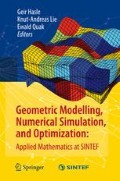Abstract
We discuss some challenges faced by neuroscientists with respect to 3D geometry reconstruction, modelling and visualization. We have developed a toolbox based on implicit representation of geometry, distributed computing and an easy to deploy and maintain graphical Java3D based interface. We describe the principles underlying this toolbox and provide an outline of the problems and suggested solutions related to a specific project, Neuroinf [18], which is a collaboration between research groups in biomedical science, informatics, and mathematics at the participating institutions. Public access to these tools will be announced on the web page.
Access this chapter
Tax calculation will be finalised at checkout
Purchases are for personal use only
Preview
Unable to display preview. Download preview PDF.
References
AIM@SHAPE-D5.1-group. Survey acquisition and reconstruction. Technical report, AIM@SHAPE, 2005.
N. Akkiraju, H. Edelsbrunner, M. Facello, P. Fu, E. P. Mücke, and C. Varela. Alpha shapes: Definition and software. In Proceedings of the 1st International Computational Geometry Software Workshop, pages 63–66, 1995.
N. Amenta, S. Choi, and R. K. Kolluri. The power crust. In Proceedings of the sixth ACM symposium on Solid modeling and applications, pages 249–266. ACM Press, 2001.
O. Andersen, G. Vasilakis. Building an ontology of CAD model information. In this book.
C. Archambeau and M. Verleysen. Fully nonparametric probability density function estimation with finite Gaussian mixture models, 2003.
J. G. Bjaalie. Localization in the brain: new solutions emerging. Nature Rev. Neurosci., 3:322–325, April 2002.
I. A. Moene, S. Subramaniam, D. Darin, T. B. Leergaard, and J. G. Bjaalie. Towards a workbench for rodent brain image data: systems architecture and design. Neuroinformatics, in press, 2007.
J. G. Bjaalie, M. Dæhlen, and T. V. Stensby. Surface Modelling from Biomedical Data In Numerical Methods and Software Tools in Industrial Mathematics, pages 329–346. Birkhäuser, 1997.
F. Couweleers, Ø. Skotheim, and B. W. Tveiten. Optical measurement of weld toe geometry with structured light. In Proceedings of 8th International Symposium on Measurement and Quality Control in Production (ISQMC). VDIVerlag GmbH, October 2004.
W. Donnelly. GPUGems 2: Programming Techniques for High-Performance Graphics and General-Purpose Computation, chapter Per-Pixel Displacement Mapping with Distance Functions, page 130. Addison-Wesley, 2005.
H. Edelsbrunner and E. P. Mücke. Three-dimensional alpha shapes. ACM Trans. Graph., 13(1):43–72, 1994.
Ø. Hjelle. Approximation of scattered data with multilevel B-splines. Technical report, SINTEF, 2001.
H. Hoppe, T. DeRose, T. Duchamp, J. McDonald, and W. Stuetzle. Surface reconstruction from unorganized points. In Proceedings of the 19th annual conference on Computer graphics and interactive techniques, pages 71–78. ACM Press, 1992.
J. Hwang, S. Lay, and A. Lippman. Nonparametric multivariate density estimation: a comparative study, 1994. IEEE Trans. on Signal Processing, 42(10):2795–2810, October 1994.
P. R. Indian. Nonparametric estimation of partial derivatives of a multivariate probability density by the method of wavelets. citeseer.ist.psu.edu/627077.html.
S. Lee, G. Wolberg, and S. Y. Shin. Scattered data interpolation with multilevel b-splines. IEEE Transactions on Visualization and Computer Graphics, 3(3):228–244, 1997.
W. E. Lorensen and H. E. Cline. Marching cubes: A high resolution 3D surface construction algorithm. In SIGGRAPH’ 87: Proceedings of the 14th annual conference on Computer graphics and interactive techniques, pages 163–169, New York, NY, USA, 1987. ACM Press.
Neuroinf project, 2001–2003. Web pages hosted by the NESYS group at the University of Oslo, www.nesys.uio.no.
J. O. Nygaard. Semiautomatic reconstruction of 3D buildings from map data and aerial laser scans. J. Digit. Inform. Manag., 2(4):164–170, December 2004.
S. Osher and R. Fedkiw. Level Set Methods and Dynamic Implicit Surfaces. Number 153 in Applied Mathematical Sciences. Springer-Verlag, New York, 2003.
S. Osher and N. Paragios. Geometric Level Set Methods in Imaging, Vision, and Graphics. Springer-Verlag New York, Inc., 2003.
E. Parzen. On the estimation of a probability density function and mode. Ann. Math. Stat., 33:1065–1076, 1962.
G. Sansoni, M. Carocci, and R. Rodella. Three-dimensional vision based on a combination of gray-code and phase-shift light projection: analysis and compensation of the systematic errors. Applied Optics, 38:6565–6573, November 1999.
J. A. Sethian. Level set methods: Evolving interfaces in geometry, fluid mechanics, computer vision, and materials science. Number 3 in Cambridge monographs on applied and computational mathematics. Cambridge University Press, Cambridge, U.K., 1996. 218 pages.
C. Sigg, R. Peikert, and M. Gross. Signed distance transform using graphics hardware. In R. Moorhead, G. Turk, and J. van Wijk, editors, Proceedings of IEEE Visualization’ 03. IEEE Computer Society Press, October 2003.
P. Zegers and J. G. Johnson. Density function estimation with multilayer perceptrons. Brazilian Symposium on Intelligent Automation (SBAI), September 2005.
Author information
Authors and Affiliations
Editor information
Editors and Affiliations
Rights and permissions
Copyright information
© 2007 Springer-Verlag Berlin Heidelberg
About this chapter
Cite this chapter
Nygaard, J.O., Bjaalie, J.G., Gaure, S., Pettersen, C., Avlesen, H. (2007). Surface Modelling of Neuronal Populations and Brain Structures: Use of Implicitly Represented Geometries. In: Hasle, G., Lie, KA., Quak, E. (eds) Geometric Modelling, Numerical Simulation, and Optimization. Springer, Berlin, Heidelberg. https://doi.org/10.1007/978-3-540-68783-2_4
Download citation
DOI: https://doi.org/10.1007/978-3-540-68783-2_4
Publisher Name: Springer, Berlin, Heidelberg
Print ISBN: 978-3-540-68782-5
Online ISBN: 978-3-540-68783-2
eBook Packages: Mathematics and StatisticsMathematics and Statistics (R0)

